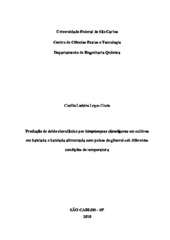Produção de ácido clavulânico por Streptomyces clavuligerus em cultivos em batelada e batelada alimentada com pulsos de glicerol sob diferentes condições de temperatura
Abstract
The production of enzymes β-lactamases by pathogenic bacteria is the most common mechanism of resistance to β-lactam antibiotics. The β-lactamases catalyze the hydrolysis of β-lactam ring, splitting the amide bond, as a result, the antibiotics become ineffective. Clavulanic acid (CA) is a secondary metabolite β-lactam produced during the fermentation of Streptomyces clavuligerus and has a potent inhibitory activity of β-lactamases. Like other β-lactam compounds, CA is chemically unstable under high temperature conditions. The decomposition of the AC during the bacterial fermentation reduces its concentration in the broth which results in low yields of the process. In this study the production of CA was evaluated in batch processes and batch with glycerol pulses at different temperature conditions in shaker operated at 250 rpm and pH 6.8. Initially, three batch cultures containing glycerol as carbon source were performed at temperatures of 30, 25 and 20ºC. Batch cultivation at 30°C was considered as a control run. Then, other three batch tests were performed with reduction of temperature of 30°C for 25 or 20°C after the exhaustion of glycerol in the broth culture. Added, also were performed four cultures with reduction of temperature associated with feeding of glycerol (1, 2, 3 and 4 pulses of glycerol), resulting in twelve cultures. In general, the production of CA increased with decreasing temperature and feeding of glycerol was beneficial for CA production. For all experiments under low temperatures, the maximum production (CCA-max) and productivity in CC (PCA-max in mg.L-1.h-1) were higher than the control run. In addition, a significant increase product (CA) yield coefficient in relation to the glycerol consumption (YCA/G, mg.g-1) reaching 59.3 mg.g-1 for the batch culture at 20°C, while for the control run was obtained 10.2 mg.g-1. The CCA-max obtained was 1115.6 mg L-1 in cultivation with temperature reduction from 30 to 25°C and three pulses of glycerol, which represented about 7 times the yield on the run control culture at 30°C. The CA degradation in fermentation broth at temperatures of 30, 25 and 20ºC was also evaluated in this study. Values of constant degradation of CA (kdCA) were obtained in different cultivation times. The highest kdCA value in the broth was obtained at 30°C, 0.01306 h-1, and values for 25 and 20ºC were statistically similar, 0.00303 and 0.00173 h-1. The higher rate of production of CA (rCA) of 10.9 mg.L-1.h-1 was observed at 25°C. The results obtained demonstrate the potential application of temperature manipulation during S. clavuligerus fermentation for the optimization of CA production process.
